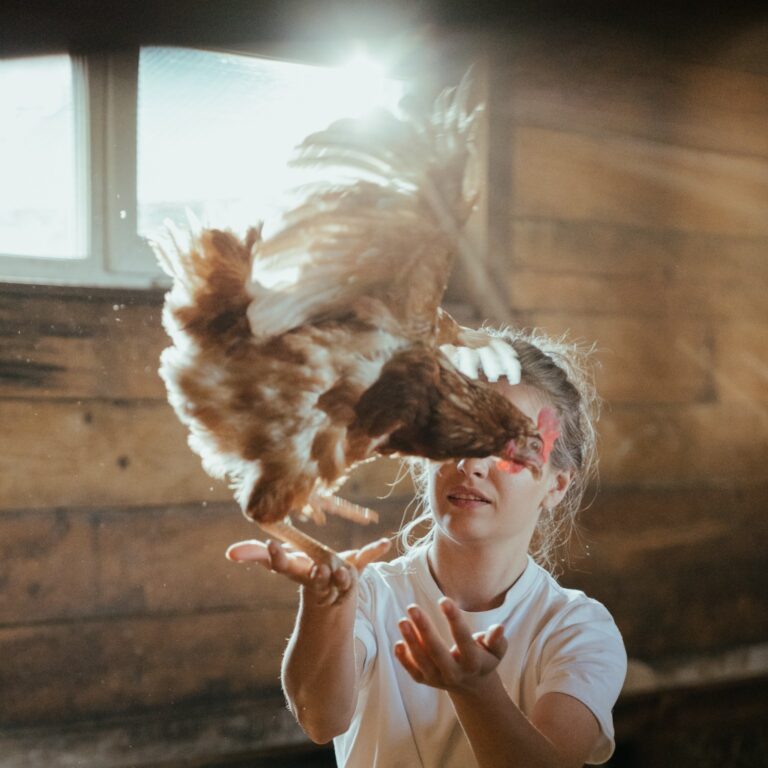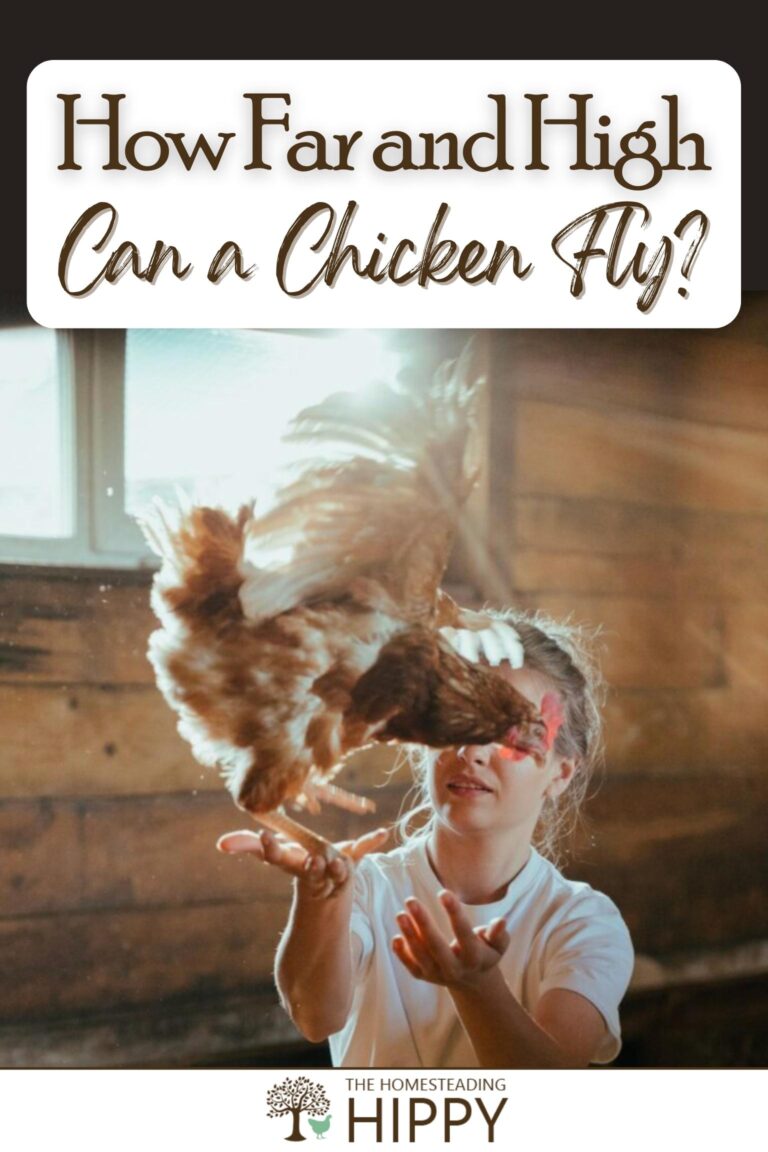Chickens are not thought of as birds capable of flight. But they have wings, and all chickens know how to use them!

It turns out that most chicken species can fly, if in a limited way, making short trips to reach higher vantages or cover more ground quickly.
Though their flight capability has diminished with centuries of selective breeding, some smaller or more athletic breeds can easily reach the top of your house or cover dozens of feet in a single bound. So, how far and how high can a chicken fly?
An average chicken can easily reach 4 to 8 feet (1.2 to 2.4 meters) off the ground, and cover 30 feet (or 9 meters) or more in distance.
Though incapable of sustained flight, some breeds can fly for quite a distance in favorable wind conditions or when gliding downhill.
I will say this: don’t underestimate their flight abilities or pretty soon you’ll have a full-blown jailbreak on your hands.
You know what they say: tall fences make for happy chickens. No? Well, something like that.
Anyway, keep reading to learn what you need to know about how far, and high, chickens can fly.
Can Chickens Really Fly?
Yes, they can. The ability to fly is instinctual, but domesticated chickens are, as a rule, not great flyers.
However, the level of flight capability varies among chicken breeds. Some smaller or more athletic breeds can easily cover a significant height or distance when they start flapping.
Even for larger breeds, or any breed that is not particularly adept at it, they can still easily use their wings to add some serious height to jumps, clearing short fences and other obstacles with ease.
How High Can Chickens Fly?
The height a chicken can reach depends on its breed and individual characteristics. An average, medium-sized chicken with intact flight feathers can easily reach upwards of 10 feet off the ground.
Some breeds can easily top that, making it to the top of your house or other outbuildings with ease!
Larger chickens, or those without well-developed flight muscles and feathers, will be limited in how high they can fly.
How Far Can Chickens Fly?
The distance a chicken can cover in flight also varies by breed and individual chicken. An average chicken with well-developed flight muscles and primary feathers intact can easily cover 30 feet or more in a single leap.
This can assist chickens in covering ground quickly or dodging predators.
When Do Chickens Usually Fly?
Chickens usually take to the air when they want to reach a higher vantage point or need to travel a distance quickly, when excited or startled.
Chickens will also fly in order to escape danger, such as predators, or to escape from captivity of course!
Why Should You Care if they Can Fly?
You should definitely care if your chickens can fly, and how good they are: your chickens can easily escape a fenced-in area or reach a place they really shouldn’t be by flying.
More than one unfortunate owner has found out the hard way that their wings aren’t for show!
When your chickens escape the safe, cultivated confines of your yard or their run, they can get into a ton of trouble.
They can get lost, be hit by cars, preyed on by all kinds of animals (including domestic dogs and cats) or damage someone else’s property. None of these outcomes are good for your chickens or you!
So, it is important to understand and keep an eye on your chickens’ flight capabilities and make sure they will remain where you want them.
If you have a particularly daring or athletic chicken, you might even want to clip their wings to help prevent any escapes.
Some Breeds are Better Flyers than Others
Certain chicken breeds are much more accomplished at flying than others. Generally speaking, the closer a domestic breed is to its ancient, jungle fowl cousins, and the smaller it is, the better at flying it will be.
Some notable flight-prone breeds include:
- Ameracauna
- Ancona
- Catalana
- Czechoslovakian Blue Splash
- Dominique
- Easter Egger
- Hamburg
- Leghorn
- Most Bantam breeds
Some of these breeds will even happily roost in trees if you don’t keep them grounded! It is imperative that you know what your birds are likely capable of before you install fencing (if relying on it)or they escape!
Some Chickens Cannot Fly at All
On the other hand, or rather wing, there are quite a few breeds that, for various reasons, are dependably flightless or so bad at it they can only jump a few feet.
A couple are even so bad they won’t really attempt flight at all! These breeds are usually large or “giant” examples of the species, or else have poorly developed feathers or flight muscles that preclude flight.
There are exceptions, as a couple bantam breeds simply do not fly. Examples of poor- and no-flyer chickens include:
- Chantecler
- Cochin
- Faverolle
- Jersey Giant
- Langshan
- Orpington
- Polish
- Rhode Island Red
- Sultan
- Wyandotte
But, as they say, there is always an exception to the rule! Certain individual chickens might be capable of exceeding typical breed norms, so observe your flock to avoid surprises.
To Keep your Chickens Safe and Under Control, Keep ’em Grounded!
A big part of being a responsible chicken owner is keeping your chickens under control and where you want them.
This also contributes significantly to their safety. Knowing how high and far your chickens can fly is a vital part of this.
While it’s fun to watch our feathered friends take to the skies now and again, it’s definitely not ideal when they do it at inopportune times or places! And believe me, they know exactly when it is least convenient for me. They just know…
If you want to keep your chickens reliably grounded, regardless of their ability, you’ll need to consider clipping their wings.
Clipping a Chicken’s Wings Will Prevent Flight
Clipping your chicken’s wings is the best way to keep them where you want them, or at least inside a fenced area, with a lot less worry that they can escape.
The process of clipping a chicken’s wings is not exactly what it sounds like: you aren’t maiming them or permanently altering their bodies.
Instead, you are only trimming their feathers in a special way to prevent or reduce flight capability.
While this might seem cruel, it is actually a common practice among chicken keepers and is not painful for the bird if done with care and caution.
The feathers will also eventually grow back, so it’s not a permanent solution unless you routinely stay on top of the chore. Clipping your chicken’s wings is relatively simple and only takes a few minutes.
Don’t Forget to Situate Roosts and Nesting Boxes with Ramps so Chickens Can Reach Them
Lastly, it is a good time to remind you that you should always give chickens a leg up in reaching their perches, roosts and nesting boxes regardless of how well they can fly or whether or not their wings are clipped.
This is because they will still need to be able to access these areas, and it can be difficult for them to do so if they are not able to use their wings to generate a little boost.
You can provide ramps or other means of easy access to these areas, or you can simply place them lower to the ground.
Generally locating their usual “hangouts” no taller than 2 feet is a good idea. Just make sure that whatever you do, your chickens will be able to reach them without any trouble.

Tom has built and remodeled homes, generated his own electricity, grown his own food and more, all in quest of remaining as independent of society as possible. Now he shares his experiences and hard-earned lessons with readers around the country.
Find out more about the team here.
